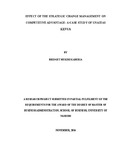| dc.description.abstract | Strategic Change management evokes different meanings depending on one's conviction.
Strategic change management concentrates on how to inspire users to acknowledge and
accept new business process and the innovation that empowers it. The directing principal
of change management is that people make organization's work, not innovation.
Innovation is only an instrument, and users must be amped up for it, have faith in it,
trained and supported in it. Consequently strategic change management is about ensuring
those things are incorporated from the earliest starting point as a component of the
venture. It is conventionally argued that change is inevitable and is a constant feature of
organisational life. The environment in which organisations operate is always changing.
Organisations must therefore develop capacity to change and adapt as fast as their
environment is changing in order to survive and prosper. The main purpose of this was to
find out the effect of the strategic change management on competitive advantage: a case
study of Unaitas Kenya. The research design was a case study. The purpose behind this
decision depended on the knowledge that case studies are the most applicable for
inspecting the procedures by which occasions unfold, and additionally investigating
causal connections furthermore they give an all-encompassing comprehension of the
wonders. The study used the interview guide in the primary data collection. The
interview focused on obtaining qualitative data. The data obtained was analysed using
content analysis which involves a systematic qualitative description of the respondent’s
answers to the questions posed in the interview guide. It included perception and detailed
depiction of the objects, things or items that comprise the study. This approach was more
fitting for the study since it took into account profound, sense, definite records in
changing conditions. In addition, it provided valuable historical and cultural insights
through analysis of texts. The study findings established that the Sacco sector is a very
important part of our economy and very stable as many of them have remained in
operation for over thirty years. However, it faces challenges just like any other sector.
The study revealed that the Saccos many challenges due to constantly changing
environmental factors. These environmental factors include factors in the individual
Saccos’ operating environment, factors facing the Sacco Sector in the County as well as
the Sacco Sector in the whole Country and the factors in the remote environment. The
major competitors of Saccos are banks, microfinance institutions, merry go rounds, nonformal
financial institutions and money transfer service such as M-pesa. The study
recommended that Saccos should also concentrate on product development strategies
such as product refinement, developing new products for the existing, expanding the
product lines in response to the environmental challenges facing the Saccos. These will
assist the Saccos maximize revenue from the existing market and therefore remain
competitive. These will assist the Saccos maximize revenue from the existing market and
therefore remain competitive. This is because Saccos target a particular group of people
who have common interests and such Saccos as Staff Saccos have a limited number of
members especially the ones serving members of staff in small organizations.
Diversification strategies also need to be considered in order to increase their market
share. The Saccos also need to consider strategies involving teaming up with some of
their competitors where possible in order to reduce the impact of the threat of
competition. | en_US |



